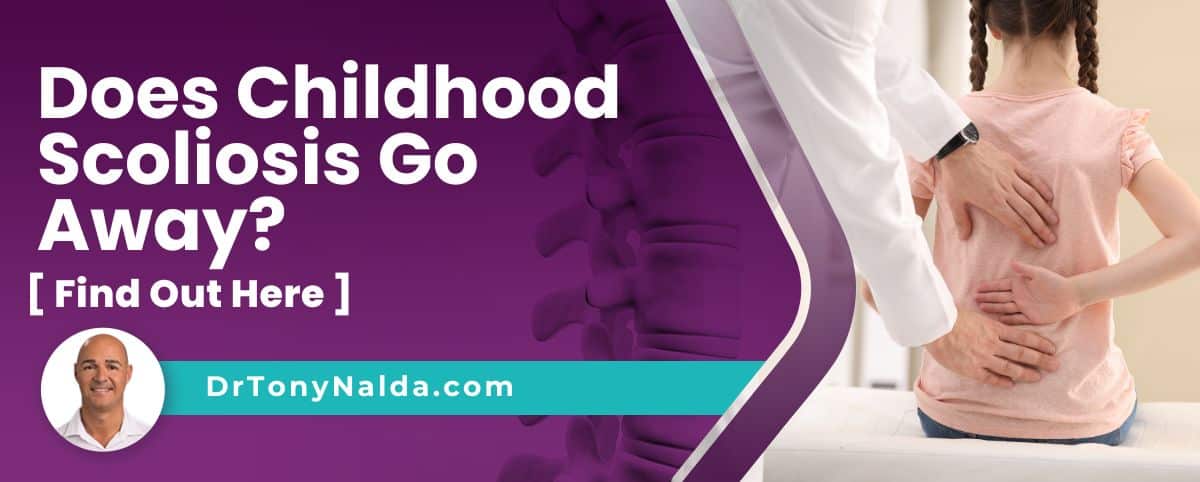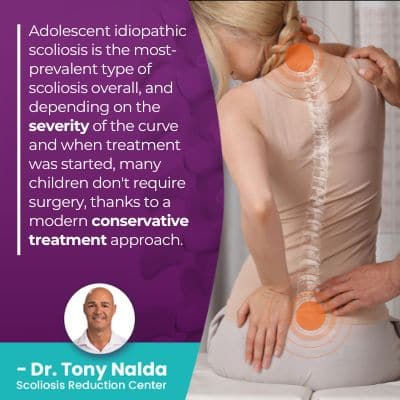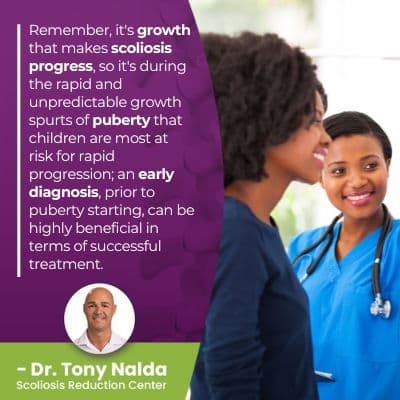Does Childhood Scoliosis Go Away? [ Find Out Here ]

No form of scoliosis will simply go away on its own, but with the right treatment plan, the condition's effects can be minimized. In fact, even though scoliosis treatment is about managing a lifelong condition, a scoliosis diagnosis doesn't have to mean a life of restrictions.
As a progressive condition, the nature of scoliosis is to get worse over time, and this means the condition is incurable; however, particularly with early diagnosis and intervention, scoliosis can be highly treatable.
As scoliosis affects all ages, and there are different age groups that fall under the umbrella of childhood scoliosis, let's discuss the different types of childhood scoliosis.
Table of Contents
Condition Type
As a spinal condition that causes an unnatural side to side curve of the spine that also rotates, scoliosis can cause a number of effects felt throughout the body.
In order to diagnose scoliosis, certain parameters have to be met, including the rotational component and a minimum Cobb angle measurement of 10 degrees.
A patient's Cobb angle determines how far out of alignment the spine is and how severe scoliosis is; the higher the Cobb angle the more severe the condition, and scoliosis ranges from mild scoliosis to moderate scoliosis, severe, and very severe scoliosis.
There are a number of other variables that treatment plans are shaped around, one of which is condition type, and this is determined by a condition's underlying cause.
The most prevalent type of scoliosis overall is idiopathic scoliosis, and this type is the most common in both children and adults.
Idiopathic Scoliosis
Idiopathic scoliosis isn't associated with a single-known cause, and approximately 80 percent of known cases involve idiopathic scoliosis, and the remaining 20 percent are associated with known causes: neuromuscular scoliosis, congenital scoliosis, and degenerative scoliosis.
Cases associated with known causes are considered atypical and have unique treatment needs and characteristics.
For example, in cases of neuromuscular scoliosis, the scoliosis has developed due to the presence of a larger neuromuscular condition such as spina bifida, muscular dystrophy, and cerebral palsy, and it's the underlying neuromuscular condition that has to be the focus of treatment.
In typical cases of idiopathic scoliosis, the curve bends to the right, away from the heart, but in atypical cases, the curve can bend to the left, towards the heart, and this also complicates the treatment focus; when I see a left-bending curve on an X-ray, this is a red flag that the scoliosis is caused by an underlying pathology.
While we don't know what causes idiopathic scoliosis, we do know what triggers it to get worse: growth.
As we are focusing on childhood scoliosis, let's talk about the different types of childhood scoliosis, and this is determined by patient age, so let's start with scoliosis that babies are born with.
Congenital Scoliosis
 Congenital scoliosis is a rare form, affecting approximately 1 in 10,000 babies who are born with the condition.
Congenital scoliosis is a rare form, affecting approximately 1 in 10,000 babies who are born with the condition.
The scoliosis is caused by a malformed spine that develops in utero; spinal malformations can include vertebrae that failed to separate when forming, instead becoming fused together as one solid bone and/or one or more vertebral bodies being more triangular in shape, than rectangular, causing the spine to form an unnatural spinal curve.
Babies born with congenital scoliosis often present with additional congenital abnormalities and need to be comprehensively assessed and monitored.
As a structural spinal condition involving an abnormality within the spine itself, congenital scoliosis can't just go away. The spine can't magically unbend and untwist itself, particularly when the constant trigger for progression (growth) is occurring.
Most cases of congenital scoliosis don't go away or improve on their own; most will progress with growth.
Infantile Scoliosis
Infantile scoliosis curves develop between the ages of 6 months and 3 years, and at this age, this is idiopathic scoliosis.
Some cases of infantile scoliosis will resolve on their own and not progress, but there is no way of knowing which infants won't and which fill face progression as the child's spine grows.
Progression means the size of the unnatural spinal curve is increasing, as are the condition's uneven forces, and their effects, and while there are never treatment guarantees, progression makes the condition more complex to treat; hence the benefit of a proactive treatment approach because as a progressive condition, virtually all cases of scoliosis will be getting worse at some point.
Juvenile Early Onset Scoliosis
 Early-onset juvenile scoliosis is diagnosed in children between the ages of 3 and 10 years of age, and what's significant about this childhood age group is that this is the age I can make the biggest impact with treatment, and this is because these children have not yet experienced their first pubescent growth spurt.
Early-onset juvenile scoliosis is diagnosed in children between the ages of 3 and 10 years of age, and what's significant about this childhood age group is that this is the age I can make the biggest impact with treatment, and this is because these children have not yet experienced their first pubescent growth spurt.
Remember, it's growth that makes scoliosis progress, so it's during the rapid and unpredictable growth spurts of puberty are when children are the most at risk for rapid progression; an early diagnosis, prior to puberty starting, can be highly beneficial in terms of successful treatment.
Young spines are malleable because they are constantly experiencing a lengthening motion; once skeletal maturity is reached, while the progressive trigger of growth is removed, the condition then becomes compressive and often painful (back pain, muscle pain, and nerve pain).
Pain is the main symptom of adult scoliosis, and postural changes (uneven shoulders, one shoulder blade protruding more on one side, uneven hips, development of a rib arch, etc.) are the main symptoms of scoliosis in children.
The best way to prevent scoliosis from getting worse and needing invasive spine surgeries in the future is proactive treatment that's started as close to the time of diagnosis as possible.
Adolescent Idiopathic Scoliosis
Adolescent idiopathic scoliosis is diagnosed between the ages of 10 and 18, and as mentioned, due to the rapid period of growth that adolescents are experiencing, adolescent scoliosis treatment has to focus on how best to counteract progression during growth.
Younger children also face progression related to growth, but an older child's spinal curve is going to progress faster during faster states of growth.
If left untreated, young adults with scoliosis will carry their condition into adulthood, when it's likely to become painful due to spinal and nerve compression, and in some cases of severe scoliosis, particularly in cases of childhood scoliosis that weren't diagnosed or treated until adulthood, spinal fusion surgery can be a common recommendation.
Spinal fusion is a lengthy, costly, and invasive spine surgery that involves fusing the curve's most-tilted vertebrae into one solid bone so they can't become more unnaturally tilted over time, and in most cases, metal rods are attached to the spine to hold it in place; however, this is known to cost the spine in terms of its overall health, strength, and long-term function.
Adolescent idiopathic scoliosis is the most-prevalent type of scoliosis overall, and depending on the severity of the curve and when treatment was started, many children don't require surgery, thanks to a modern conservative nonsurgical treatment approach.
Conclusion
So does childhood scoliosis go away? As a progressive condition, in the vast majority of childhood scoliosis cases, treatment is needed to manage the condition, counteract progression during growth, and avoid the need for invasive future surgical treatment; scoliosis isn't known to go away on its own.
Childhood scoliosis always needs to be taken seriously because as it's triggered by growth, the more growth a child has to go through prior to reaching skeletal maturity, the more potential progression they can experience.
As scoliosis gets worse, it becomes more painful for adults for whom the condition is progressive, and for children, the postural changes become more noticeable, as do accompanying disruptions to balance, coordination, and gait.
Here at the Scoliosis Reduction Center, my patients benefit from a proactive conservative treatment plan that's particularly beneficial to condition types facing potential rapid-phase progression; it's generally far more effective to proactively work towards preventing progression than it is to work towards reversing its effects once they're established.
As a child's curve progresses, it's getting larger and more rigid, making it less responsive to treatment, and here at the Center, my approach is chiropractic-centered and integrative; I combine the power of multiple scoliosis-specific treatment disciplines so conditions are impacted on every level.
In addition to manual adjustments and a variety of chiropractic techniques, I also rely on physical therapy, wearing a brace, and rehabilitation.
The most important thing to know about childhood scoliosis is that the best time to treat scoliosis is always now; mild curves are simpler to treat, and scoliosis patients whose treatment is started early in the condition's progressive line tend to respond better.
Dr. Tony Nalda
DOCTOR OF CHIROPRACTIC
After receiving an undergraduate degree in psychology and his Doctorate of Chiropractic from Life University, Dr. Nalda settled in Celebration, Florida and proceeded to build one of Central Florida’s most successful chiropractic clinics.
His experience with patients suffering from scoliosis, and the confusion and frustration they faced, led him to seek a specialty in scoliosis care. In 2006 he completed his Intensive Care Certification from CLEAR Institute, a leading scoliosis educational and certification center.
About Dr. Tony Nalda
 Ready to explore scoliosis treatment? Contact Us Now
Ready to explore scoliosis treatment? Contact Us Now





